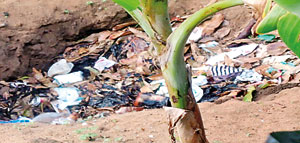
Letters to the Editor
Look beyond fumigation and burning garbage to tackle dengue menace
It was reported that from the beginning of July, thousands of soldiers, airmen and sailors have supported the Public Health Inspectors (PHIs) in a house-to-house campaign to identify mosquito breeding areas and take corrective measures.
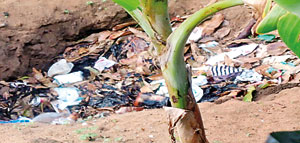 I live in Kochchikade (Negombo) and, alas, I have hardly seen attempts to identify mosquito breeding places in my area- no officials have visited my or neighbouring premises, although there were many people in the area affected by dengue. Somebody said households would be inspected on July 12 and if a mosquito breeding place was found, the owners of the premises would be liable to a fine of Rs. 50.000,000. No officials turned up but, everybody tried to clean their surroundings by lighting massive fires and burning all accumulated rubbish, plastic items included.
I live in Kochchikade (Negombo) and, alas, I have hardly seen attempts to identify mosquito breeding places in my area- no officials have visited my or neighbouring premises, although there were many people in the area affected by dengue. Somebody said households would be inspected on July 12 and if a mosquito breeding place was found, the owners of the premises would be liable to a fine of Rs. 50.000,000. No officials turned up but, everybody tried to clean their surroundings by lighting massive fires and burning all accumulated rubbish, plastic items included.
A couple of days later, there was a thundering sound and from a cloud of smoke, like in one of those Doomsday films (Apocalypse now), appeared a ghastly figure with a mask and a menacing looking fogging device. I was told to go inside my house and close the door. I obeyed but later on I wanted to find out whether that fogging had any effect on the mosquito population. Half an hour later, around six p.m., the first mosquitoes flew into the house and I managed to kill them with an electric mosquito swatter. Next morning, as I usually sleep with an open window under a mosquito net, I found and killed some 30 more of them.
 The Daily Mail of September, 2016
The Daily Mail of September, 2016
There is data which suggests that mosquitoes have become resistant to the chemicals used in fumigation and may not die. Furthermore, fogging kills other insects that feed on mosquitoes. Dengue has to be controlled at the larval stage. It is commendable that the Sri Lankan government decided to seek foreign help in fight against dengue and is ready to introduce a new method to rein in dengue.
Many Sri Lankans, believe that burning rubbish, including plastics, can deter mosquitoes. This is an illusion and therefore, the media, governmental bodies, schools and other public institutions should educate people about the menace of burning plastic items in their gardens. It is indisputably proven that burning plastics emits carcinogenic, toxic smoke and causes Chronic Obstructive Pulmonary Disease and sometimes cancer.
S. Mack
Via email
Engineers’ protest against new power plan lacks professionalism
In a letter to the Minister of Power and Renewable Energy Ranjith Siyambalapitiya on July 27, the Ceylon Electricity Board (CEB) Engineers’ Union (EU) has demanded the urgent intervention of the minister to get the CEB to facilitate the unhindered procurement of future power plants as per its Least Cost Long Term Generation Expansion Plan (LCLTGEP). Extracts of this letter were published in the media, in a press article, which reported that the Ceylon Electricity Board (CEB) Engineers’ Union (EU) allegedly levelled several allegations against the Public Utilities Commission of Sri Lanka (PUCSL) in respect of its decision to reject the CEB’s Long Term Generation Expansion (LTGE) Plan and recommending an alternative Plan comprising natural gas operated power plants in place of coal power plants as proposed by the CEB.
Among these allegations are:
1. PUCSL lacks people of proven calibre who will function objectively and in a professional manner.
2. PUCSL has no discretionary powers to amend the submitted plan on its own.
3. PUCSL’s action in approving the LCLTGEP 2018-2037 of the CEB is totally unsatisfactory.
The concerns raised by CEB in the said letter, that PUCSL is not staffed by “people of proven calibre who will function objectively and in a professional manner”, is a matter of dispute taking into consideration the fact that the recommendation made by the PUSCL, balances the health and safety of the very people whose energy demands are being met with the LCLTGEP 2018-2037. This decision boasts of the holistic approach by the PUCSL as opposed to the short sighted approach of this concentrated group of highly respected professionals making these allegations. Further to this, the CEBEU states that they “had no other option but to resort to trade union action to safeguard their membership and the sector from such individuals”.
One wonders why the CEBEU as a trade union feels their membership will get affected when decisions are being made to humanize the issue and for the betterment of the community as a whole?
It is accepted that professionals express an opinion supported by scientific facts and giving sound reasoning in rejecting and/or accepting the opinion of another. Therefore one would expect the CEBEU to also reveal as to why they reject this decision of the PUCSL, without resorting to levelling allegations against a parallel public institution in what reeks strongly of prejudice.
The press release claims that the PUCSL has not acted according to the provisions in the Electricity Acts. But the fact is that it is the CEB who has violated the provisions in the Electricity Act in preparing its LTGE Plan. The Amended Electricity Act No. 31 of 2013 says “For the purpose of this section- “Least Cost Long Term Generation Expansion Plan” means a plan prepared by the transmission licensee and amended and approved by the Commission on the basis of the submissions made by the licensees and published by the Commission, indicating the future electricity generating capacity requirements determined on the basis of least economic cost”.
The CEB’s LTGE Plan has been prepared based on the cost of production incorporating the amortized capital cost, operation and maintenance costs and fuel cost only. There is no economic component taken into account, obviously because being engineers, CEB staff may not have any knowledge of economics to prepare a Plan based on least “economic” cost. Hence, before protesting against the PUCSL Plan, the least the CEB EU could do at this stage is to consult an economist and find out how to include “economic” cost into their equation. Since the draft Plan submitted by CEB to the PUCSL does not conform to the country’s law as it is not based on least “economic” cost, it is not legal and no one can enforce it.
The bottom line is that when the economic component is added, the least cost option shifts from coal power to gas power. If the CEBEU opposes to gas power for future generation for whatever the reasons, they should come out with it giving valid reasons as professionals, without threatening to strike.
Source – 13/08/2017, The Sunday Times, see more at – http://www.sundaytimes.lk/170813/plus/letters-to-the-editor-2-254334.html
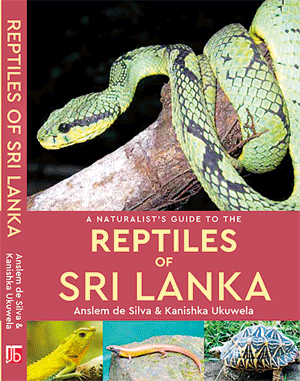
Handy guide to Sri Lanka’s reptiles
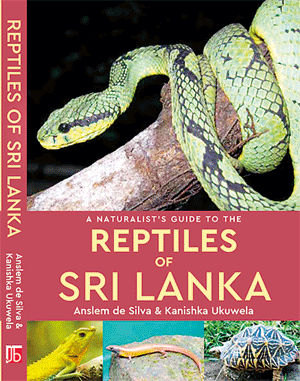 There is a long string of publications focusing on nature not only linked to Sri Lanka but also the region.
There is a long string of publications focusing on nature not only linked to Sri Lanka but also the region.The latest to ‘roll off the presses’ from John Beaufoy Publishing based in Oxford, England, are herpetological titles including ‘A Naturalist’s Guide to the Reptiles of Sri Lanka’ by Anslem de Silva and Kanishka Ukuwela. The guide will be launched next month at the International Book Fair.
This 176-page paperback is filled with colour images, 300 in all, and may be ordered from Vijitha Yapa Publications on www.vijithayapa.com.
It is described as an easy-to-use identification guide to the 150 species of reptiles including snakes, lizards and turtles, most commonly found in Sri Lanka, with their features, distribution, habitat and habits given in detail. An overview of the climate, vegetation, folklore and snake-bite management is also part of the guide.
A complete checklist of the reptiles in the country along with their status, both regionally and internationally, is available within its pages.
John Beaufoy Publishing is an independent book publisher which specializes in the fields of natural history, travel and adventure, with a focus on the tropical regions of Southeast Asia, Africa, Central America and the Caribbean: The parts of the world lying between the tropics of Cancer and Capricorn.
Source – 13/08/2017, The Sunday Times, See m,ore at – http://www.sundaytimes.lk/170813/plus/handy-guide-to-sri-lankas-reptiles-253976.html

Punishing drought takes heavy toll across Puttalam district
The Puttalam district is experiencing its worst ever drought in the past four and a half decades – and the residents suffering from its devastating effects lament the Government’s assistance is woefully inadequate.
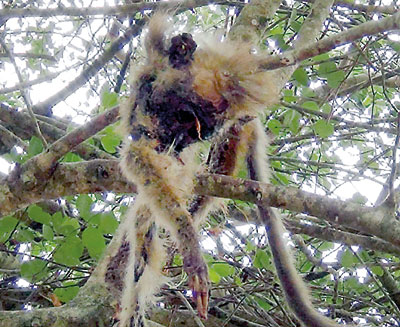
Thabbowa: Dead monkeys on tree tops
A Sunday Times investigation found that the drought has affected more than 164,000 people in 14 of the district’s 16 divisions. The Disaster Management Center’s (DMC) Puttalam office has deployed 17 water bowsers to distribute drinking water to the residents, whereas the situation demands at least double that number to meet the drinking water requirement of the residents. According to DMC’s own admission, at least another 19 bowsers are needed.
District Secretary N.M.N. Chitrananda said the most pressing problem faced by officials engaged in providing drinking water to the affected people was that even the few remaining water sources were fast drying up As such, he said he had instructed divisional secretaries to dig wells at the bottom of dried up water tanks. Permission has also been granted to construct tube wells, overruling objections raised by the Water Resources Board, he said.
The drought, now into its ninth month, has also dealt a severe blow to the economic life of the people who make a living out of cultivation. About 1,250 of the district’s 1,300 small irrigation tanks have now dried up. The water levels of the district’s two main reservoirs at Inginitimitiya and Thabbowa have decreased drastically. Paddy cultivation is at an all-time low while subsidiary crops such as betel, bananas and tea have also been virtually wiped out.
In Nawagattegama, more than100 betel fields have been affected. As a result, about 500 daily paid labourers have lost their jobs, Divisional Secretary R.P.G. Podineris said.
Those engaged in inland fishing said they would also be jobless soon if the drought continued.
Also hit by the punishing drought are dairy farmers. With grazing areas fast dwindling and water in short supply, farmers struggle to keep their cattle alive.
According to North Central Province’s Department of Animal Production and Health, some 50,000 cattle in the Puttalam district are at risk due to severe food and water shortages.
The prolonged drought has also severely disturbed the region’s eco-system. Forest areas are scattered with the carcasses of wild animals which died agonising deaths without water. Bodies of dead monkeys on trees are a common sight.
Source – The Sunday Times, See more at – http://www.sundaytimes.lk/170813/news/punishing-drought-takes-heavy-toll-across-puttalam-district-254390.html
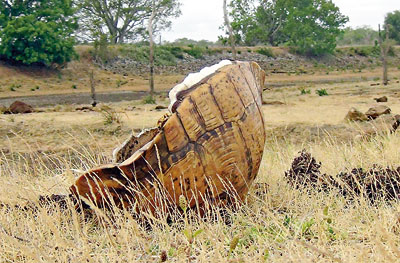
Welcome rain brings some relief, but not enough to end drought
While torrential rains this week brought much needed relief to several drought-hit regions, officials warned that the drought itself is set to continue at least until the beginning of October.

Nuwara Wewa, Anuradhapura
Anuradhapura, Polonnaruwa, Trincomalee and Mullaitivu districts all received heavy rainfall over three days this week, resulting in significant improvement in some areas affected by drought. The most striking example was in the Trincomalee district. The Disaster Management Center’s (DMC) statistics issued a week ago on August 5 noted that nearly 141, 000 persons from more than 37, 000 families in the district were affected by the drought. This number has fallen to 36, 000 people from 10, 700 families as of yesterday (August 12). “The rains have significantly improved the situation in the Trincomalee district,” DMC’s Assistant Director Pradeep Kodippili, the told the Sunday Times. Mr Kodippili however, warned that there were still no signs that the drought was abating.
The rains “aren’t enough” and besides Trincomalee, the situation in most other areas remained the same, the official stressed.
The main problem continues to be a severe shortage of drinking water. Mr Kodippili explained the DMC has been distributing drinking water to drought-affected areas for the past eight months using about 500 bowsers, 200 of which were sent into service within the past two months as the drought became more intense. About 6000 water tanks have also been delivered to affected areas.
More than 1.24 million people from over 360, 000 families in 19 districts were affected by the drought as of yesterday, according to the DMC. Kurunegala district remained the worst with 200, 000 being affected, up from 151, 000 a week ago. This meant almost 60, 000 families. Puttalam district with over 164, 000 affected people was next. Jaffna District saw 128, 652 persons affected while the number in Mulliativu stood at 115, 308. Between 85, 000 to 90, 000 persons were affected in each of the districts of Anuradhapura, Vavuniya, Kilinochchi and Mannar.
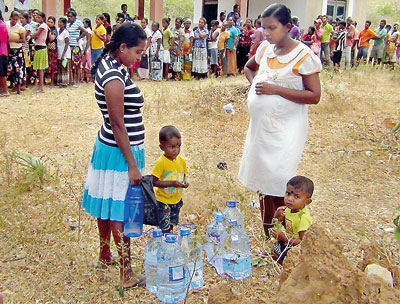
Mahakumbukkadawala: Waiting for potable water
Meteorology Department Director K.H.M.S Premalal observed that water was still scarce in most drought-hit areas despite the rains this week. “We have to remember that many tanks in the affected areas have either run dry or their water levels have dropped considerably,” he pointed out. There has to be a prolonged period of heavy rain for the effects of the drought to diminish, and such rains are only expected towards the end of September when the inter-monsoonal rains become active, he added.
Inter-monsoonal rains generally account for 30 per cent of the country’s total rainfall and their effectiveness will be vital in ending the drought period, Mr Premalal noted.
The Irrigation Department has 73 major tanks coming under its purview. The total balance water availability of these tanks has now fallen to just 14 per cent, Wasantha Bandara Palugaswewa, Director of Irrigation (Water Management & Training) disclosed. “Many smaller tanks have run completely dry.”
Nevertheless, the Department had been able to release water adequate to cultivate about 50 per cent of paddy lands due to be cultivated during the ‘Yala’ season, Mr Palugaswewa claimed. “Despite the difficulties, we were able to release water for cultivation purposes and we are now at the tail end of the Yala season.” Water was still being released from certain large tanks in the Anuradhapura and Polonnaruwa districts.
Mr. Palugaswewa added that heavy rains which were experienced in Anuradhapura and Polonnaruwa this week was an encouraging sign and said officials were hoping for more of the same.
The drought has also impacted hydropower generation. However, some heavy rains were also experienced this week in areas where hydropower reservoirs are located. Maussakale, Castlereigh, Kotmale, Norton Bridge, Canyon, Lakshapana and Kukuleganga hydropower reservoirs received rains this week. This has resulted in total water levels of hydropower reservoirs reaching 39.6 per cent by yesterday, up from about 36.4 per cent two weeks ago, Director (Development) of the Ministry of Power and Renewable Energy and Ceylon Electricity Board (CEB) Spokesman Sulakshana Jayawardena stated. This however, is only a minor increase, he insisted.
At present, just 20 per cent of the country’s daily electricity demand is being met by hydropower. The balance 80 per cent is being generated mainly by diesel and coal power.
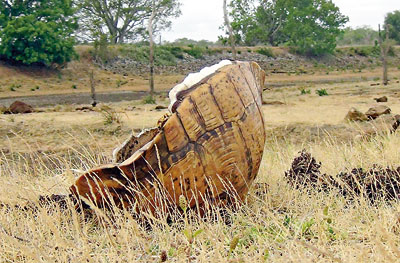
Thabbowa: Dead tortoise

Meegaswewa: Providing drinking water for hard-hit wild animals
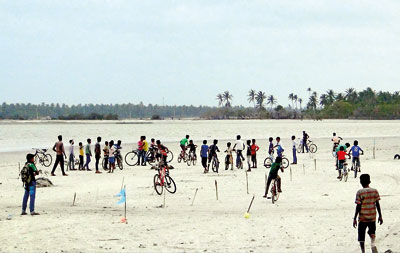
Dried up tank in Kalpitiya. Pix by Athula Bandara, Hiran Priyankara Jayasinghe and Karuwalagaswewa Jayaratna
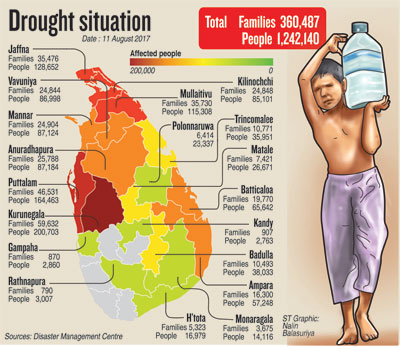
Source – 13/08/2017, The Sunday Times, See more at http://www.sundaytimes.lk/170813/news/welcome-rain-brings-some-relief-but-not-enough-to-end-drought-254393.html
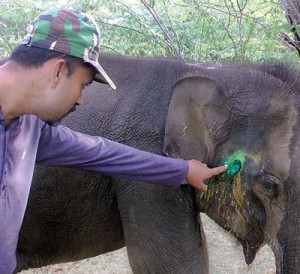
Explosives killing hundreds of elephants, protection handicapped
A four-year-old elephant, which had suffered severe injuries after biting an explosives-packed device used to hunt wild animals for human consumption is fighting for its life.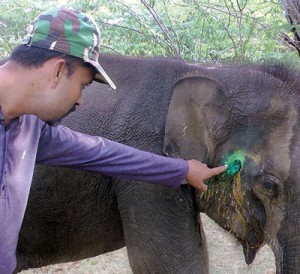
The illegal device commonly known as —‘hakka pattas’ — a mixture of explosives with lead and ball bearings inserted into a piece of pumpkin had been placed in a location in Hambantota. It is at that site where the wounded animal had been found nearly two weeks after the incident.
The explosion had mutilated its jaw bones, teeth, and ripped off a foot long piece of trunk. The animal is being treated at the Elephant Transit Home Udawalawe.
Veterinary surgeon, Dr Malaka Abeywardena told the Sunday Times that even after three days of treatment, there had not been any improvement as of Friday.
“Due to the damage to the jaw and teeth of the elephant calf it has to take liquid food. It is malnourished and weak making anaesthetised surgery impossible.’’
Dr Abeywardena said that that the calf would have roamed near Hambantota harbour for over a week after being wounded. The animal’s mouth and the side of it’s head was infested with maggots.
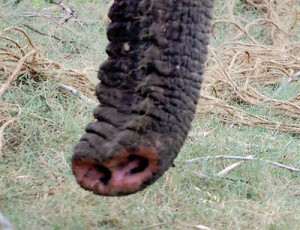
“Antibiotics are given twice a day, while saline, energy boosting medicine and vitamins are given regularly,’’ he said.
Incidents of elephants being killed by using hakka patas, shooting them or poisoning them are on the rise.
Within the last five years, from 2012 to 2016 around 1,171 elephants have died out of which only 104 had died due to natural causes, according to the Wildlife Department.
The survey on the elephant population done in 2011 revealed that the number of elephants in the country around 5,800.
Statistics show that during last year alone 279 elephants were found dead and only 35 of them had died due to natural causes.
Dr Tharaka Prasad, director of wildlife health at the Wildlife Department as well as the chief veterinary surgeon, said more deaths take place because of gun shot wounds.
He said that a tusker and another elephant suffering from gunshot injuries are struggling for their lives in Kala Wewa, Anuradhapura and in Minneriya respectively.
“Elephants which are shot can only be identified when the animal shows signs of weakness or seen limping towards a pool of water. Its too late then as it is badly infected by that time,’’ he said.
Dr Prasad noted instances of elephants wounded by trap guns set up by farmers and surviving for years after the wounds heal, but the corrosion of the iron balls embedded in their flesh, kills them eventually.
He explained that some farmers kill elephants by using toxic pesticide in vegetables. Electric fences can also kill elephants in minutes or within days.
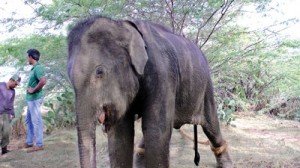
The explosion had mutilated the baby elephant’s jaw bones, teeth, and ripped off a foot long piece of trunk. Pix by Rahul Samantha Hettiararchchi
“At least three elephants are found dead every week. If an animal that has been poisoned, eaten hakka patas, or has suffered burn injuries from an electrical source, is found alive, there is little chance to save it,’’ he explained.
There are 15 wildlife veterinary surgeons, but their main task is to handle any epidemic situation in wildlife parks and not individual cases.
Meanwhile, wildlife rangers, guards and officials from various parks spelt out the difficulties that they face in elephant conservation. There is not enough staff for monitoring, for raids, to investigate those who set explosives, or those who leave poisoned food in the paddy fields bordering forests.
There is also not water in Galagmuwa, Giribawa, Hambantota, and Meegalawa because of the drought. Water is brought in by tanker trucks only into some areas.
“The elephants which roam in search of water take down electric fencing and enter villages.The villagers shot them,’’one of them said.
The lack of staff means they have to call up the unarmed Civil Defence Force to help. They are not trained to handle wildlife issues.
The rangers also claimed that some elephants are wounded by their own officers because they use live ammunition, not rubber bullets.
Director general of the DWC, M G C Sooriyabandara, said that over 65% of elephant deaths are caused by shooting.
Elephants who fall victim to hakka pattas could suffer for over three months and starve to death.
Mr Sooriyabandara said that use of hakka pattas within or outside of wildlife reserves is illegal, but detection is difficult.
“According to the Fauna and Flora Protection Ordinance any person who kills or harms any protected animal is liable to a jail term and or a fine of Rs 200,000 to Rs 500,000.
Mr Sooriyabandara admitted that the DWC is short staffed, but said offenders can be arrested.
He denied that live ammunition is used and explained that rubber bullets are provided to officers for emergencies.
“We never encourage officers to shoot animals. We never provide live ammunition, but if individuals are using them we will investigate.’’
Minister of Sustainable Development and Wildlife, Gamini Jayawickrama Perera, said he wants to find the companies making firecrackers that provide people with gunpowder to produce hakka pattas.
If animals continued to suffer, new laws will have to be drafted to restrict gunpowder issued to villagers, he said.
Mr Perera said that the department needs at least 1,000 officials. He had informed the cabinet that 200 people are urgently needed.
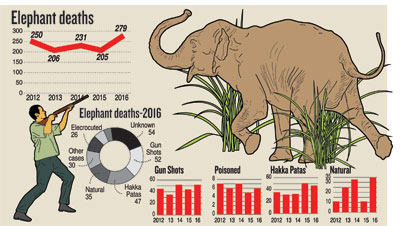
Source – 13/08/2017, The Suinday Times, See more at – http://www.sundaytimes.lk/170813/news/explosives-killing-hundreds-of-elephants-protection-handicapped-254356.html
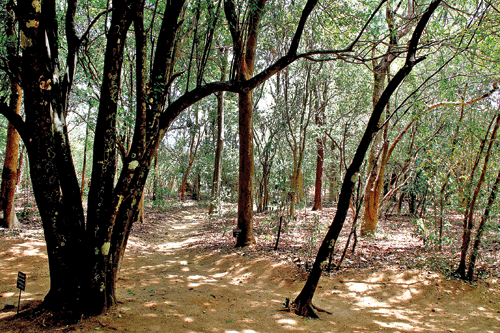
Celebrating the uniqueness of Popham’s Arboretum
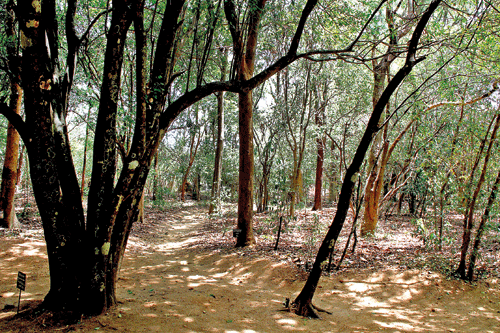
Growing wild: Popham’s vision realised. Pix by Indika Handuwala
I have been on so many overseas expeditions but this visit to Sri Lanka is undoubtedly the best so far both in terms of biodiversity and hospitality. Such diversity within one canvas is just incredible,” says Josh Raper, a Falmouth University Marine and Natural History Photography graduate. Josh is among the group of visiting Falmouth students on an expedition tour in the National Institute of Fundamental Studies (NIFS) – Popham Arboretum in Dambulla.
The research team of Conservation Photography students led by Dr. Margaret Upton, Senior Lecturer from the Falmouth University, UK, was here on a one-month tour in July. The first international visit of this scale to the Popham Arboretum, set up by the British planter and former naval officer, Francis Home Popham way back in 1963, it aims to promote international research at this only naturally regenerated arboretum in the country.
The arboretum which Sam Popham gifted to the then Institute of Fundamental Studies (IFS), in 1989 is presently managed on behalf of NIFS now (National Institute of Fundamental Studies), by Ruk Rakaganno.
The tour was facilitated by Prof. Mayuri Jayasinghe from the Faculty of Zoology and Environment Sciences, University of Colombo on a link made possible by Simon Lazenbatt, a member of Ruk Rakaganno. Simon, a one-time ‘pharmaceutical guy’ whose professional commitments first brought him here in 1984, was bowled over by the natural beauty of the island. “I kept coming for vacations with my wife who too fell in love with the place, so much so we both wanted to live here after my retirement and here we are having realized our dream,” says Simon who has made his abode in Naula.

Sam Popham
Simon who came to associate with the Arboretum through his involvement with Ruk Rakaganno initially linked up the Zoology Faculty of University of Exeter. “The zoological tour which did not materialize last year, finally evolved into an educational tour of photography this year with Falmouth University tying up,” explains Simon who sees it as a stepping stone to more progressive ventures in time to come. A database of photographic material is being generated and will be donated by the Falmouth group. This valuable resource material, with proper management and the will and vision to utilise it properly, can be used to produce promotional materials and items for sale to visitors, says Simon. “Currently there are no informative or souvenir items available for sale, which means a huge opportunity to support the Arboretum has been lost up to now,” he notes.
NIFS-Popham Arboretum which is home to around 200 species of flora, among them, several endemics, is also a place to see the Slender Loris. The arboretum in the dry zone proudly proclaims its genetic diversity. “We couldn’t have expected a better place which would do justice to our theme of ‘Science meets Photography,” reflects Josh Pawlowski, second year student of Marine and Natural History Photography at the Falmouth University who is excited about developing a series of documentaries together with his fellow students.
These documentaries will bring under the spotlight the evolution and the importance of the Popham Arboretum and its flora and fauna with special emphasis on the Loris. Their specialist gear, including heat sensitive and night vision appliances, enable non-obtrusive observation of the wild life and more sophisticated documentation of the behaviour and ecology of the Loris population in particular. An exhibition celebrating the arboretum and its biodiversity, is also in the pipeline says Josh for whom the first time ‘tropical experience’ has been just overwhelming. Such exposure, as the young photographer asserts, it is hoped, will kindle interest in the Arboretum in UK-based wildlife media and other like-minded individuals.
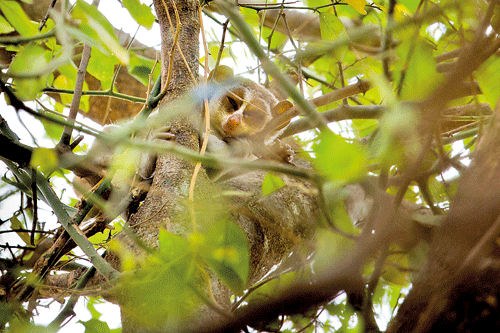
Additional attraction: The slender Loris. Pic by Lewis Easdown
For Josh Raper, the visit had been a thrilling photographic experience, along with a food encounter with Sri Lankan pumpkin and spinach! For Meike Simms, a Zoology graduate, currently working in wildlife tourism, the Popham Arboretum also offered insights into other issues such as what levels of tourism should be best for Sri Lanka in terms of sustainability without disturbing the natural equilibrium, especially in wildlife parks, she notes. Our potential for wildlife tourism is enormous, says Meike who also asserts that collaborations of this nature become a bonus in the process.
The mud hut which is at times an auditorium transforms into a lunch room where all youngsters help themselves to a simple Sri Lankan lunch where papadam seemed to hold sway and monkeys keep them amused! Held in nature’s rapture, they look forward to the next visit to the island, with the Kandy Perahera and tea estates on their bucket list.Lauding the NIFS-Ruk Rakaganno collaboration which made the visit possible, Dr. Margaret Upton looks forward to similar student-centric encounters in the near future. “With the intervention of Prof. Mayuri Jayasinghe, hopefully we can enter into a MoU with the University of Colombo, so that a mutual learning experience will be possible and exercises of this nature could be sustained.”
The conservation of the Arboretum fuelled by schemes of this nature becomes increasingly decisive, given the exclusivity of the place, says Prof. Jayasinghe. “Compared to the wet zone, endemism in the Dry Zone is poor further intensified by the post-war phase where forests have been cleared at an alarming rate. In this backdrop, the Arboretum emerges an exception with its rich biodiversity converged into an inclusive landscape of around 36 acres,” she observes.

Margaret Upton
Several interactive sessions were held with leading researchers and scholars including Prof. Wipula Yapa, Head, Department of Zoology and Environment Sciences, University of Colombo and Prof. Siril Wijesundara, Research Professor from NIFS.
The visit of the students had been at a ‘critical juncture’, says Prof. Siril Wijesundara who serves on the management committee of the Arboretum. He urges for sustainable scientific collaborations both local and international which would reflect positively on research as well as the Arboretum which requires upgrading. “Although we have had on-site research programmes before, this is the first time a venture of this scale is taking place and through the proposed tripartite MoU, we hope to promote theme-based research,” he says.
With the more consolidated partnership between NIFS and Ruk Rakaganno coming into place, the conservation efforts of the Arboretum certainly appear to be more encouraging, asserts President, Ruk Rakaganno, Kamini Vitarana. “With both Prof. Wijesundara and Prof. Jayasinghe on board, more robust undertakings look possible,” says Ms. Vitarana, adding that international spotlight is a step in the right direction.
Source – 13/08/2017, The Sunday Times , See more at – http://www.sundaytimes.lk/170813/plus/celebrating-the-uniqueness-of-pophams-arboretum-253991.html



